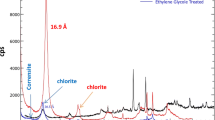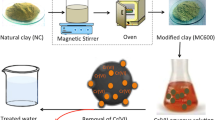Abstract
Al-Madra clay, a local, cheap and readily available material in Qatar, was tested for the removal of copper ions from aqueous solutions. Batch experiments of copper ion adsorption onto natural and treated clay in different conditions were undertaken. Different types of activated Al-Madra clay were used, such as Na-clay, Al-clay, thermal-clay and cyclohexane-clay. Thermally treated clay achieved the highest removal of Cu ions, followed by Al-clay, cyclohexane-clay, and finally Na-clay. A maximum of 50% adsorption of copper ions can be achieved using the natural clay while about 72% adsorption can be achieved when the clay is thermally treated. The amount of copper adsorbed by untreated Al-Madra clay was dependent on the process conditions; increasing with an increase in pH and initial metal concentration but decreasing with an increase in sorbent concentration. The increase in temperature from 5 to 50°C resulted in only a very slight increase in copper uptake by untreated Al-Madra clay.
Résumé
L’argile d’Al-Madra, un matériau local, bon marché et facilement exploitable au Qatar, a été testée pour l’extraction d’ions cuivreux à partir de solutions aqueuses. Des expériences en série, portant sur l’adsorption d’ions cuivreux sur des argiles naturelles ou traitées en différentes conditions, ont été réalisées. Plusieurs types d’argiles d’Al-Madra activées ont été testés, tels que des argiles saturées en Na, en Al, traitées thermiquement ou au cyclohexane. Les argiles ayant subi un traitement thermique ont donné les meilleurs résultats pour l’extraction des ions cuivreux, suivies par les argiles saturées en Al, les argiles traitées au cyclohexane, et finalement les argiles saturées en Na. Un taux d’adsorption d’ions cuivreux de l’ordre de 50% peut être obtenu à partir des argiles naturelles, tandis qu’un taux d’environ 72% est obtenu à partir des argiles traitées thermiquement. La quantité de cuivre adsorbée par les argiles d’Al-Madra non traitées dépend des conditions opératoires, augmentant avec une augmentation du pH et la concentration initiale en métal, diminuant avec une augmentation de la concentration de l’adsorbant. Une augmentation de la température de 5 à 50°C n’a apporté qu’une très faible augmentation de l’adsorption de cuivre par l’argile d’Al-Madra non traitée.





Similar content being viewed by others
References
Abu-Zeid M, Al-Kuwari A (1989) Distribution, genesis and thermal behavior of clay minerals in the Miocene argillaceous rocks in Qata, Arabian gulf
Al-Asheh S, Banat F, Abu-Aitah L (2003) Sep Purif Technol 33:1
Banat F, Al-Bashir B, Sl-Asheh S, Hayajneh O (2000) Environ Pollut 107:391–398
Banat F, Al-Asheh S, Abu-Aitah L (2002) Adsorpt Sci Technol 20:151–191
Basso MC, Corrella EG, Cukierman AL (2002) Ind Chem Eng Res 16:3580
Chen XH, Gosset T, Thevenot DR (1990) Water Res 24:1463
Cheung WH, Ng JCY, Mckay G (2003) J Chem Technol Biotech 78:562
Ferro-Garcia MA, Rivera-Utrilla J, Rodriguez-Gordillo J, Bautista-Toledo I (1988) Carbon 26:363
Garg VK, Gupta R, Kumar R, Gupta RK (2004) Bioresour Technol 92:79
Ho YS, Porter JF, Mckay G (2002) Water Air Soil Pollut 141:1
Huang C, Huang CP (1996) Water Res 30:1985
Huang C, Huang CP, Morehart AL (1991) Water Res 25:1365
Low KS, Lee CK, Lee KP (1993) Bioresour Technol 44:109
Ma W, Tobin JM (2003) Water Res 37:3967
McKay G, Ho YS, Ng JCW (1999) Sep Purif Technol 18:87
Meunier N, Blais J-F, Tyagi RD (2002) Hydrometallurgy 67:19
Mineral Gallery, http://www.mineral.gallaries.com (September, 2004)
Smith EF, McCarthy P, Yu TC, Mark HB Jr (1977) J Water Pollut 49:633
Theopharis DG, Albanias TA, Petrakis DE, Pmonis PJ (1998) Water Res 32:295
Wong KK, Lee CK, Low KS, Haron MJ (2003) Chemosphere 50:23
World Health Organization (WHO) (1994) Guidelines for drinking water quality. Geneva, Switzerland, pp 1–2
Author information
Authors and Affiliations
Corresponding author
Rights and permissions
About this article
Cite this article
Al-Asheh, S., Banat, F. & Al-Derham, A. Assessment of Al-Madra clay as an adsorbent of copper ions from aqueous solutions. Bull Eng Geol Environ 66, 289–294 (2007). https://doi.org/10.1007/s10064-006-0069-7
Received:
Accepted:
Published:
Issue Date:
DOI: https://doi.org/10.1007/s10064-006-0069-7




